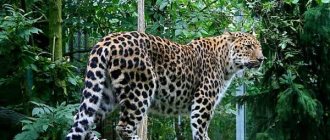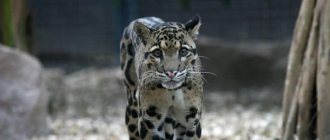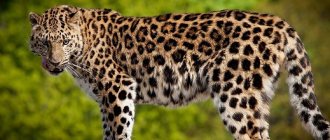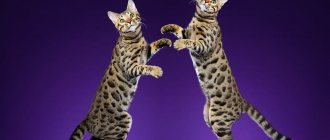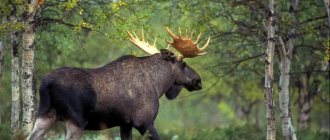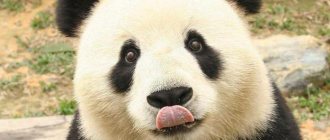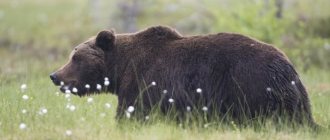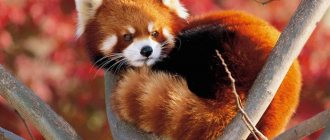One of the most colorful, graceful, majestic and cunning animals of the cat family is the leopard. He is very careful and fast, he is distinguished by a strong, muscular, strong body and keen eyesight. Leopards see perfectly in any light, and their claws and teeth are amazingly sharp. But the most important distinguishing feature of this type of predator, which also serves as an excellent means of camouflage, is its coloring. The leopard's spotted fur is predominantly white, black and brown. Now leopards are listed in the Red Book as an endangered species that is protected.
Description of the leopard
Leopards are large cats, but they are smaller than tigers and lions.
They have an elongated, muscular body, slightly compressed from the sides, light and slender, very flexible, with a long tail. The limbs are short, strong, with powerful and wide front paws. The head is small, round in shape with a convex forehead, small ears, rounded, set wide. The eyes are small. There is no mane or elongated hair on the neck and cheeks. Vibrissae are black and white, up to 110 mm in length. — Advertising —
The body size and weight of a leopard depends on the region where it lives: forest dwellers are usually smaller and lighter. The body length is 90-190 cm, the tail is 60-110 cm long. Females weigh from 32 to 65 kg, males - from 60 to 75 kg. The height of males is 50-78 cm, in females it does not exceed 45 cm.
The coat is short, close-lying, coarse and dense. Summer and winter fur have virtually no differences, the latter is slightly paler and duller. The main color background is yellow or red-yellow with small black spots that form rings with light centers.
2. Leopards are the smallest representatives of the group of big cats, ahead of them are jaguars, lions and tigers.
3.The average height of a leopard to the shoulders is about 70 centimeters. And the body length of leopards is from 100 to 150 centimeters.
4.Most leopards live in the grasslands of sub-Saharan Africa, although they are also found in other areas of the continent, the Middle East and Asia.
5.Leopards live not only in forests and jungles, but also in open spaces, and forest dwellers are usually smaller than their plains relatives.
Panther and leopard
6. Panther and leopard are different names for essentially the same animal, only leopards with a rare black color are called panthers.
7.Black and spotted babies can be born in the same litter
8.The origin of the word leopard also refers to two names for cats of prey - the Greek words leon (lion) and pardus (panther).
9.There are hybrids of leopards with lions, jaguars and pumas.
10.As a species as a whole, leopards are not in danger of extinction, but some subspecies do suffer, especially those living outside of Africa.
Ceylon leopard
11. Subspecies of leopards that are on the verge of extinction: South Arabian leopard; Far Eastern leopard; Central Asian leopard; Ceylon leopard; Javan leopard.
12. According to experts, about 500 thousand leopards live in nature - this is 10 times more than lions, tigers and cheetahs combined.
13. Among all the big cat species, leopards are the best at climbing trees.
14. Leopards are skilled, fast hunters and dexterous scavengers; their ability to adapt to various types of natural conditions can be the envy of many predators.
15. These big cats give preference to damp places where there are bodies of water nearby, but the largest number of leopards live in Africa and Asia.
Far Eastern leopard
16. The homeland of the Far Eastern leopard is the Far East of our country and the North of China. That is why it was called “Far Eastern”. But in zoology, this species of animal is known under a completely different name, namely the Amur leopard or Amur leopard.
17. Today the population of the Far Eastern leopard is in critical condition. And in the last century, in the Chinese provinces, as well as in Korea, these animals lived in large flocks.
18. It is interesting that the Far Eastern leopard changes the intensity of fur color. This phenomenon can be observed when the seasons change. For example, in summer their color is brighter and more intense than in winter. All this helps the leopard to camouflage itself perfectly depending on the season.
19. Representatives of the Far Eastern species of leopards for settlement in most cases choose regions in which large areas are occupied by forests, as well as moderate temperatures and natural precipitation (rain, snow). These predators inhabit one of the remote areas of the Primorsky Territory, not far from the border of the Russian Federation and China.
20. For the Far Eastern leopard, a nomadic lifestyle is not typical at all. After all, by their nature they are conservatives, which means that they live where they immediately settled. They even take the same route.
21. The leopard is the only feline that snags and eats its prey in a tree.
22. If a leopard has caught and killed prey, it tries to drag the carcass up a tree and eat it there so that other predators - lions or hyenas - do not take it away.
23.Leopards are able to adapt to almost any habitat, from deserts to dense forests. It is probably precisely this quality that they owe to the fact that they have spread so widely across various regions of the planet.
24. In addition to strong paws, leopards also have a fairly strong neck. This is what allows them to grab and drag a victim that is almost twice their size and weight.
25. Leopards are “nocturnal, solitary hunters.” They never go hunting during the day. And they appear at the watering hole only at dusk.
26. The color of animal skins is often determined by their habitat. For example, leopards living in the savannah have an orange or yellow coat color that blends in with the terrain. The leopards that inhabit the desert have acquired a sandy coloration of fur.
27. Leopards that live in harsh, cold environments have long grayish fur, while rainforest leopards have golden fur.
28. The spots on leopards' fur can be round or square and help the animal hide in its environment, remaining less noticeable.
29. The arrangement of spots on the skin of each leopard is unique - there are simply no two identical ones, just as there are no people with the same fingerprints.
30. Nature has endowed the leopard with a slender and fairly elongated body. They also have a long, straight tail. It plays an important role during the jump, namely to perform cool maneuvers.
31. Each individual leopard has its own hunting territory, which it marks with urine and claw marks.
32. Male leopards weigh from 60 to 75 kilograms, and females - from 32 to 65 kilograms.
33. Male leopards can kill a baby giraffe and then drag its carcass up a tree.
34. The territory of a male often overlaps with the territories of several females, whose “domains” are usually much smaller.
35.Leopards warn each other of their presence with loud cries.
36. Female leopards can give birth at any time of the year and usually have 2-3 cubs in a litter.
37.The mother hides her kittens for about 8 weeks until they learn to move, play and hunt independently.
38. The female begins to bring meat to the kittens at the age of 6 to 7 weeks, although the cubs continue to suckle her milk for about 3 months.
39. Kittens live next to their mother for about 2 years. After this, leopards begin to lead a solitary lifestyle, existing in complete solitude.
40. Leopards feed on a variety of fish, reptiles, as well as mammals of various types, such as baboons, antelopes, wild boars, hares and rodents.
41. A leopard can reach speeds of up to 57 kilometers per hour when running. This is 2 times less than the same figure for a cheetah, but still a very high speed for an animal.
42. Leopards can roar like lions, of course, not as loudly, and purr like domestic cats.
43. In the wild, leopards live 12-15 years; in zoos, there are cases where they lived up to 23 years.
44. Leopards have a special ankle structure that helps them quickly climb trees.
45. Leopards have excellent eyesight; they can see prey at a distance of 1.5 kilometers.
46. Leopards are also excellent swimmers and often catch fish and crabs in the water.
47. Leopards’ hearing is about 5 times more acute than that of humans.
48. Leopards can interbreed with jaguars and lions, but the offspring from such marriages are sterile and incapable of reproduction.
49. All leopards are born with blue eyes. Then the iris of the eyes changes color.
50. Leopards are excellent tree climbers and often descend from a tree trunk head down. They are the largest cats that constantly climb trees. Leopards can often be seen sleeping high on branches.
Clouded leopard
photo from the Internet
Leopard feeding habits
The main favorite food of leopards is roe deer, deer, and antelope.
Predators watch their victims near bodies of water, then jump and cling to the neck, killing the prey. Then they hide the carcass high in the trees, lifting up even the bodies of animals three times larger than themselves. If there are not enough ungulates, then the leopard hunts hare, birds and even monkeys. Can feed on carrion. In general, the leopard’s diet helps cleanse the environment of weak animals, that is, it is a kind of natural selection. Leopards often steal each other's prey from trees, as it can remain there for 2 to 7 days, depending on how hungry the predator that caught it is.
Appearance
The Far Eastern leopard is an unusually beautiful and graceful cat with thick lush fur, a flexible slender body, strong paws with strong retractable claws and a long tail (photo 1, 2, 2-a). This subspecies lives in the coldest climate, and it is not surprising that it has the thickest and warmest fur (in winter its length ranges from 5 cm on the back to 7 cm on the lower part of the body). The basis of the Far Eastern leopard’s diet is wild artiodactyls: sika deer and roe deer, less often wapiti calves and young wild boar. However, other animals can also become its prey: badgers, raccoon dogs, hares, musk deer, foxes, weasels, squirrels, hedgehogs, hazel grouse and pheasants. The leopard always hunts alone, with the exception of females with grown kittens. The beast's vision is very sharp, and it can see prey at a distance of up to 1.5 km. Like leopards of other subspecies, this animal easily climbs trees even with large prey. If necessary, he is able to endure long (up to 20 days) hunger strikes.
Leopard distribution
— Advertising —
Leopards are common in Africa and Asia, in the north of the Caucasus Mountains and in the Amur taiga. For life they choose savannas, mixed forests and mountain slopes.
In general, these predators adapt well to any environment. So, on the African continent they live in jungles, savannas, semi-deserts and mountains. But coniferous and dense tropical and subtropical mixed forests of Asia are also becoming an acceptable habitat for them.
Habitat and conservation status
This subspecies of leopard is widespread in Iran, Turkey, Turkmenistan, Uzbekistan, Pakistan, Afghanistan, North and South Ossetia and Dagestan. It lives in subalpine meadows, deciduous forests and dense thickets of bushes.
The total population size of this leopard subspecies is estimated at 870-1300 individuals. About 550-850 individuals live in Iran, 200-300 in Afghanistan, 90-100 in Turkmenistan, 10-13 in Azerbaijan, 10-13 in Armenia, less than 5 in Georgia and Turkey. The subspecies is listed in Appendix I of the Convention on International Trade in Endangered Species of Wild Fauna and Flora (CITES). In all states where the Central Asian leopard , it is protected. It is listed in the Red Book of Russia as an endangered species and classified as category 1.
Common Leopard Species
For the leopard, the following subspecies are distinguished depending on the regions of their habitat:
- African leopard (Panthera pardus pardus) in Africa
- Indochinese leopard (Panthera pardus delacouri) in Indochina
- Javan leopard (Panthera pardus melas) on acute Java
- Indian leopard (Panthera pardus fusca) in India, southeast Pakistan, Nepal
- Ceylon leopard (Panthera pardus kotiya) in Ceylon
- North China leopard (Panthera pardus japonensis) in China
- Far Eastern leopard (Panthera pardus orientalis) in the Far East, northern China, Korea
- Persian leopard (Panthera pardus saxicolor) in Western Asia and the Caucasus
- South Arabian leopard (Panthera pardus nimr) on the Arabian Peninsula.
Nutrition
The Persian leopard feeds mainly on medium-sized ungulates: deer, goitered gazelles, mouflons, bezoar goats, Dagestan aurochs and wild boars. It also eats smaller animals: rodents, hares, porcupines, jackals, various mustelids, birds and reptiles.
1397
12677
12678
12679
Leopard behavior
Leopards usually lead a solitary lifestyle, except during the mating season.
Like many other predators, they are nocturnal. During the day they climb trees, where they rest quietly, and at dusk they go out hunting. Leopards are good steeplejacks and can easily jump onto trees or rocks up to 5 meters high. Leopards are distinguished by acute vision and keen hearing. Even in pitch darkness they can navigate perfectly. And their ideal protective color helps predators camouflage. This is why even experienced hunters often miss leopards. Their location is usually revealed by a long tail, which they cannot tuck, and if the animal is excited, the tail moves, which also attracts attention.
Leopards are the main threat to monkeys. The latter, when they notice a predator, try to climb as high as possible into the trees and begin to scream loudly. Even large baboons avoid meeting a leopard.
These cats very rarely attack humans, only if they are injured or provoked.
Behavior in natural conditions
The mother understands that sooner or later the children will grow up and leave her, which means that they must be able to take care of themselves. To this end, she brings wounded game into the den, allowing the kittens to learn how to win. Over time, the training becomes more complicated, the kids begin to accompany their mother on the hunt, track down prey with her, monitor the hunt, and later try their hand at attack and pursuit.
Another essential skill is tree climbing. Leopards do this simply perfectly, better than most other animals. If after hunting and eating there is still some food left, the animal usually drags it up a tree so that jackals and wolves do not get it. By the way, the leopard himself is not averse to taking prey from someone who is weaker, for example, from a cheetah.
Leopard breeding
In the south of its range, the leopard breeds throughout the year.
In the Far East, mating season occurs in late autumn or early winter. At this time, fights often occur among the males; they roar loudly, although they usually behave very silently and quietly. Pregnancy lasts 3 months, after which 1-2, sometimes 3 blind babies are born. Females choose caves, crevices, and holes in remote, secluded places as dens. At the age of 2.5 years, the young leopard reaches the size of adults and becomes sexually mature, moving on to independent life.
Small predators
Leopards have a number of distinctive features. The spots at birth look more like shapeless specks; only after a few weeks do rosettes with red centers and dark edges form. Some leopards have elevated levels of melatonin, causing so many dark spots on their skin that the animals appear black. Such leopards are called panthers (yes, this is not a separate species, but only a color feature). As a rule, the trait is inherited; black leopard cubs are born with a much darker coat than most of their relatives.
Pay attention to the leopard's pupils - they are round, not vertical, like those of a domestic cat. In the photo, the leopard cubs look like cute plush toys. But the appearance of these animals is deceiving. The mother quickly teaches them all the skills necessary for a wild animal. Kittens over three weeks old can already fend for themselves.
Natural enemies of the leopard
Agile, secretive and strong, adult leopards have virtually no enemies.
Their food competitors are the lion, hyena, and tiger, which can steal prey that leopards hide in the trees. In recent years, the leopard population has been steadily decreasing. The main threat to them was human activity: hunting, destruction of natural habitats, reduction of food supply. Previously, leopards were hunted for the purpose of obtaining their valuable and beautiful skins, but now poaching is associated mainly with the needs of oriental medicine. For example, at the beginning of the 21st century, the number of individuals of Far Eastern leopards was only about 50. Five subspecies of leopard, including the Far Eastern one, are included in the IUCN and Russian Red List. Hunting them is prohibited.
Leopard cubs in captivity
The leopard has practically no natural enemies, but human activity causes significant damage to populations. In the old days, a significant number of these animals were exterminated because of their beautiful skins. Today, many animals are also dying due to deforestation and development of areas where they previously lived, as well as due to a decrease in the number of herbivores that can be hunted.
Some species are on the verge of extinction. But strict hunting control is clearly not enough, therefore, in order to preserve populations and restore their numbers, people breed leopards in nurseries and zoos.
In captivity, a female usually gives birth to one kitten, which is supplemented by veterinarians if necessary. Experts monitor the health of females and babies and study the behavior of animals. Of course, it is too early to talk about complete victory, but there is still some success in preserving the species.
Interesting facts about the leopard:
- As among lions and tigers, among leopards, although extremely rare, there are cannibals; old or sick animals that are unable to hunt ungulates. In the 20s of the last century, the “Rudraprayag cannibal” became widely known in India. He killed 125 people, sneaking into villages and people's homes at night. Leopards also begin to attack people after being injured by porcupine quills. In such cases, the animal becomes crippled, loses mobility, and begins to attack humans, since it cannot fully hunt ungulates.
- Leopards are a symbol of cruelty, ferocity, aggression, and fearlessness. Since the spots of this predator are similar to eyes, it is called the Vigilant Guardian. The Chinese consider leopards to be a symbol of courage and warlike ferocity. In Ancient Egypt it was associated with the supreme god Osiris, and among the Greeks with Dionysus.
Reproduction and lifespan
It is interesting to watch these animals during the rut. Each male tries to win the most beautiful female and prove that he is the one worthy of her. This is determined by their fights and competitions with each other.
As soon as their breeding season arrives, leopards that prefer solitude take off. The den is landscaped by the female. She chooses a place away from prying eyes in crevices, caves or holes under trees.
The female's pregnancy lasts approximately 90 – 110 days. After this, from one to three babies are born, who are completely blind and helpless. They can be spotted or pure black, depending on the presence of pigment.
Only the female raises the babies, but the male is always next to them. Young leopards live with a female from 1 to 1.5 years. During this time, she manages to put them on strong paws and teach them all the tricks of their habitat.
When they reach 30 months, leopards leave their parents' den and begin to lead an independent lifestyle. Animals from the Red Book, the leopard , is one of the most interesting wonders of nature, which we, people, need to preserve at all costs.
Feeding leopards
As a rule, the leopard's diet consists of ungulates - roe deer, deer and antelope. Sometimes it can feed on monkeys and rodents, as well as snakes and birds. Can hunt horses and sheep. Dogs, as well as wolves and foxes, often suffer from leopards. For lack of food, an animal sometimes steals prey from its relatives. As for humans, predators rarely attack people - to do this it is necessary to disturb the leopard. But he will certainly attack if he is wounded - in this case the consequences will be very sad.
Habitat and distribution of leopards
There are many more places where leopards live than places where any other cat species live. Leopards are common in forest-steppe and forest areas , as well as in mountainous and savannah areas of the African continent. This species of cat also inhabits the southern territory of Asia. Leopards once inhabited Transcaucasia, most of Africa, India and Pakistan. Their habitats also included Sri Lanka, Zanzibar and the island of Java.
Today, in many historical habitats, this species is either very rare or completely extinct. These countries include Zanzibar, Sinai Peninsula and Morocco. In other places, the range of leopards has a structure divided into separate populations located at a considerable distance from each other. If we consider the territory of Russia, then leopards can live in the Primorsky Territory. It is also possible to meet an animal in the Caucasus.
Speaking about African leopards, it should be noted that they mostly like to live in the jungles located in the central part of the continent, as well as in the highlands. These predators are also found in the semi-deserts and savannas of Morocco. Leopards are in dire need of water, so they avoid living in dry places, avoiding areas of Namibia and the Sahara.
In Asia, animals typically live on the Amur in coniferous forests , as well as in subtropical and tropical forests, which are found on the plains and on the mountain slopes of India and South Asia. The habitats of leopards in Asia continue all the way to the Arabian Peninsula. These animals are not found only in the arid deserts of Asia, as well as in Borneo and Sumatra. However, archaeological finds confirm that leopards once inhabited Sumatra. Today's habitat of leopards covers parts of Afghanistan, Kashmir and the Caucasus, including the Himalayas.
Habitat of leopards in the Caucasus
In the Caucasus, the leopard population declined significantly at the end of the 20th century, becoming simply insignificant. We can confidently say that in this area these predators are on the verge of extinction. In the Caucasus, the range of leopards is located mostly in forested foothills.
The range begins in the western areas, not far from Tuapse, and covers the northern territories. Then it reaches the eastern part until the end of the Caucasus Range. As for the foothills, leopards inhabit their forests and are sometimes found in their upper sections, less often above its border. The habitat of animals at the foot of the Caucasus ridge descends all the way to the slopes of the mountains, and in Transcaucasia the habitats covered the foothills of the Lesser Caucasus, including the area between Kura and Rion.
The habitats of animals in Central Asia are represented in Western Asia - in Afghanistan and Iran . This area is conventionally divided into several parts.
- In Turkmenistan, the main part of the range is represented by Kopetdag.
- In Central Asia, the habitat is located on the right bank of the Pyanj and Amu Darya rivers.
- The Far Eastern habitat belongs to the Korean Peninsula and Northeast China. This part of the range is located in Transbaikalia, the Amur region and the Ussuri region.
